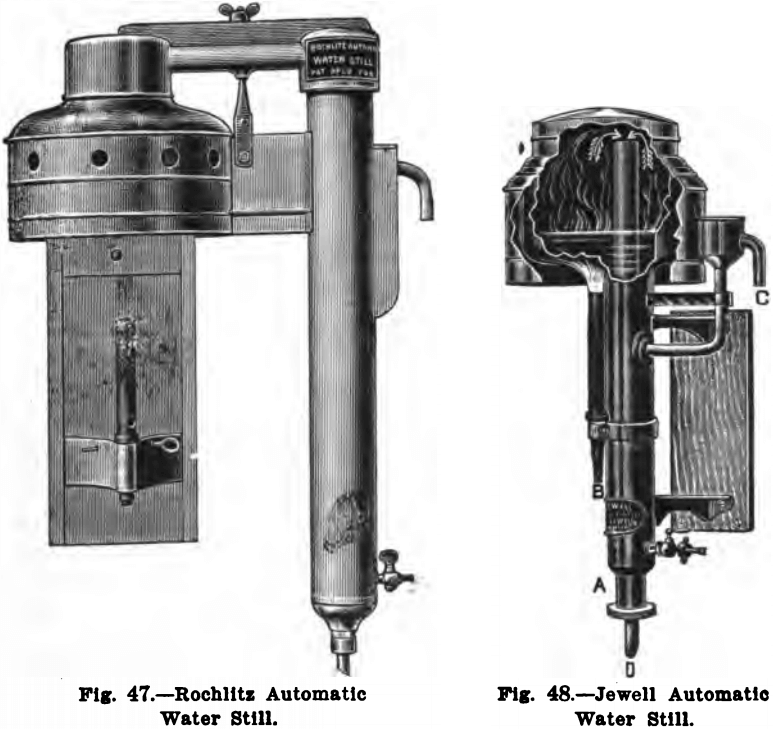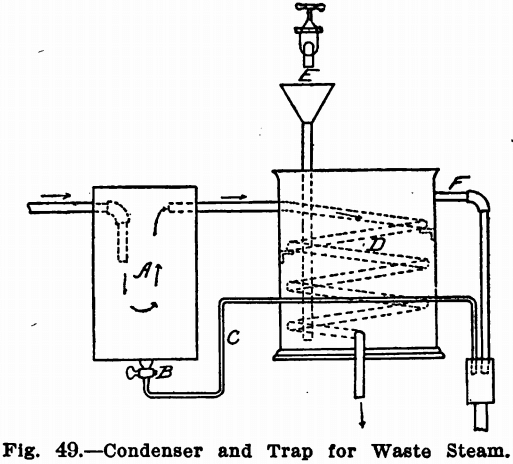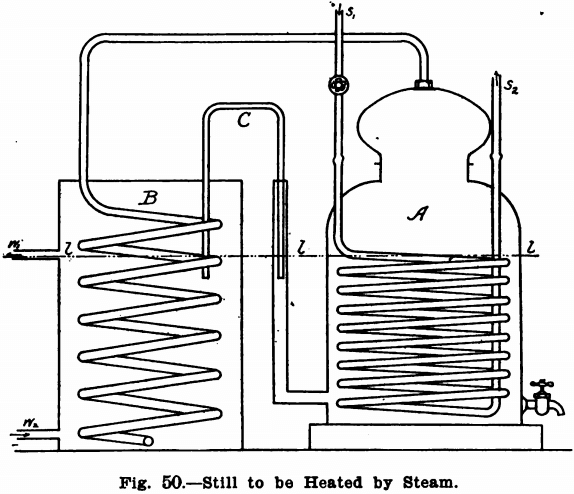Table of Contents
Automatic Stills
For the preparation of distilled water in the laboratories, nothing are quite so handy as the automatic laboratory stills sold by various dealers in chemical supplies. One of the best forms of these is the Jewell automatic water still, another good form is the Rochlitz automatic water still, Fig. 47, made for The Scientific Shop, 324 Dearborn Street, Chicago. This latter form the author has in his laboratory and it is probably necessary to operate it not more than a third of the time to supply all the water needed for the analytical work. It gives the

purest water of any of the small stills which we have examined. When pushed it will distill at the rate of about one gallon every two hours. The Jewell still, Fig. 48, is made in a number of sizes, the smallest costing very little and having a capacity of ½ gallon per hour and the largest costing little with a capacity of gallons an hour. These stills are all meant to be heated by gas, though the smaller sizes may be heated by a gasolene burner. The Rochlitz still may be heated over a small oil stove as it differs somewhat in construction from the Jewell still.
Condensing Steam from Boilers
Other forms of automatic water stills are on the market and are described in various

dealers’ catalogues. The automatic stills are so cheap that it hardly pays to get a copper retort and tin worm to distill water. While a few dollars first cost may be saved by purchasing these, the extra trouble of watching the latter, in order to prevent its boiling dry, and the extra amount of gas required to do the work, negative any such saving in a few weeks. Steam from the heating line may also be condensed for distilled water. In this event a trap should be interposed between the steam line and the block tin pipe coil in order to catch any drip from the iron pipe. Figure 49 shows an arrangement of this kind. A is the trap. It is a small drum made of galvanized iron, planished copper or iron pipe. It is provided with a drip cock, B, and a small siphon, C, which will automatically draw off the water when it reaches a certain height. D is the worm. It should be made of block tin pipe. The cooling water enters at E and leaves at F the steam is drawn from the boilers of a large plant it is apt to contain oil, which will condense with the water and the latter will appear milky and smell of kerosene. While for some work this may not be objectionable, still such distilled water makes the beakers greasy and the burette levels hard to read, so that it is far better to get one of the automatic stills either heated by gas or steam. Where gasoline lamps are used the Rochlitz still, mentioned before, may be used and heated by a coal oil stove, if the gasolene lamps are troublesome or the gas supply is limited.
Large Stills
When large volumes of water are needed a large size Jewell still heated by live steam from the boilers of the plant will be found most convenient and economical. They are made in sizes ranging in capacity from 3 to 30 gallons per hour and hence are large enough to meet any laboratory demand. The F. J. Stokes Machine Co., 17th and Cambria Sts., Philadelphia, also make automatic stills of great capacity and efficiency to be heated by live steam.
A retort heated by steam, such as is shown in Fig. 50, may also be attached to the condenser illustrated in Fig. 49. This is made of copper and is heated by means of a coil of ¾-inch copper pipe coiled around the inside of the retort. This coil is connected with the steam line. The steam from the retort passes up into the dome and from this into a worm through a block tin pipe. As the water boils away from the retort more is automatically supplied through the siphon tube shown.
Containers for Distilled Water
For holding distilled water one or two-gallon bottles are best, because one can be filling while the other is being used, etc. Distilled water attacks glass, dissolving silica, so that it should not be kept any great length of time. For this reason it is best to get a still which without pushing will distill a day’s supply of water in a morning, and have freshly distilled water on hand every day, using one day the water prepared the morning before, and emptying each bottle before using the next. Tanks lined with block tin are used, as distilled water attacks tin very little. They should be soldered with pure tin. Carboys, stone jugs, jars, etc., of large capacities should not be used to hold distilled water in laboratories where inorganic gravimetric determinations are made, as water kept in such vessels is sure to become contaminated with silica, etc., giving high results. For the same reason the practice of using large stills heated by coal fires and run only now and then, long enough to fill up tanks or bottles with sufficient water to supply the laboratory for a month or two, is decidedly objectionable, on the score of accuracy. Distilled water should be occasionally tested for contaminations by evaporation in a weighed dish.
